Jet Lag Pro: A Mobile Platform for Evaluating Chronoacupuncture as a Tool for Jet Lag Management
A Pilot Study Proposal
Steven Schram PhD, DC, LAc
© 2025 Steven Schram. All rights reserved.
Abstract
Background: Jet lag affects over 90% of long-haul travelers, and current management strategies including light therapy, melatonin, and sleep scheduling show inconsistent results. Chronoacupuncture, a Tradicional Chinese Medicine (TCM) approach involving acupressure stimulation of a specific class of acupuncture points known as horary points at time-specific intervals, has been proposed as a non-pharmacological intervention but has never been systematically evaluated.
Objective: This pilot study proposes to evaluate chronoacupuncture as a potential intervention for jet lag using a mobile health platform, JetLagPro, designed to guide acupressure stimulation and collect real-world outcome data.
Methods: Participants will use the JetLagPro mobile application to receive timed prompts for self-administered stimulation of horary points aligned with their destination time zone. Following travel, participants will be encouraged to complete an online survey to assess resultant symptom severity. That, along with app trip data is persisted in the survey data.
Expected Outcomes: Our plan is to generate preliminary data on effectiveness and symptom reduction across diverse travel conditions. Results will determine whether chronoacupuncture can be effective as a non-photic synchronizer of circadian rhythms.
Significance: This study is the first systematic investigation of chronoacupuncture for jet lag. Findings will clarify whether chronoacupuncture offers an effective low-cost and non-invasive intervention for travelers.
Keywords: chronoacupuncture, circadian rhythm, jet lag, horary points, Traditional Chinese Medicine, acupressure
Introduction
The global increase in air travel has made jet lag a widespread health concern, with economic implications including reduced productivity and increased healthcare costs. Current interventions of light therapy, melatonin, strategic sleeping and varied meal scheduling show variable efficacy. Individual differences in circadian flexibility further complicate treatment approaches.1
Acupuncture theory offers an alternative perspective through its understanding of temporal physiology. The Chinese Organ Clock, documented in classical texts dating back millennia, describes a 24-hour cycle where different organ systems reach peak activity during specific two-hour windows. This temporal theory by the ancient sages parallels modern discoveries in circadian biology, where peripheral clocks in organs coordinate with the central circadian pacemaker.
Chronoacupuncture applies this temporal theory by stimulating specific acupuncture points during their designated active periods. For jet lag applications, we use the destination time zone rather than local time for stimulation scheduling, theoretically facilitating faster circadian adaptation. Despite advocacy and use among acupuncturists, this approach lacks systematic evaluation, representing an information gap between traditional practice and evidence-based medicine.
Circadian Biology: Mechanisms of Internal Clocks
Circadian rhythms synchronize physiological processes to a 24-26 hour cycle, governed by the suprachiasmatic nucleus (SCN), a hypothalamic cluster of neurons entrained by light via melanopsin containing retinal cells.2,3 The SCN coordinates peripheral clocks in organs like the liver and heart, which regulate tissue-specific functions including vascular function and blood pressure regulation.4,5 Core clock genes (Clock, Bmal1, Period, Cryptochrome) drive a molecular feedback loop, producing rhythmic gene expression.6 Synchronization is maintained by Zeitgebers, external signals such as light, temperature, activity, and meals.7
Jet lag occurs when rapid time zone changes desynchronize these clocks, delaying adaptation. Adaptation rates vary widely, underscoring the need for effective interventions. This scientific framework parallels acupuncture's temporal perspective, as embodied in the Chinese Organ Clock, suggesting a synergy between modern circadian biology and traditional acupuncture practices.
Acupuncture Theory: A Temporal Understanding
Acupuncture theory maps physiological processes to a 24-hour cycle through the Chinese Organ Clock, where vital energy (Qi) flows through 12 meridians, each peaking during a two-hour window.8 Our focus is on the horary points, which are specific acupuncture points along these meridians that are especially active during these peak periods (Figure 1).
Over 40 years ago, Khoe and then Amaro postulated that stimulating horary points sequentially during travel could help pre-synchronize our organ systems to new time zones, targeting jet lag's circadian misalignment.9,10 While jet lag was unknown in ancient times, the time theory of acupuncture meridians was documented and understood in terms of the cyclical nature of all body functions including digestion, activity and rest. This parallels the SCN-driven circadian rhythms described earlier.
While acupuncturists report using horary points for jet lag for many decades, no studies have validated its efficacy, hence this study. We intend to evaluate chronoacupuncture and quantify the effect of horary point stimulation on jet lag symptoms.
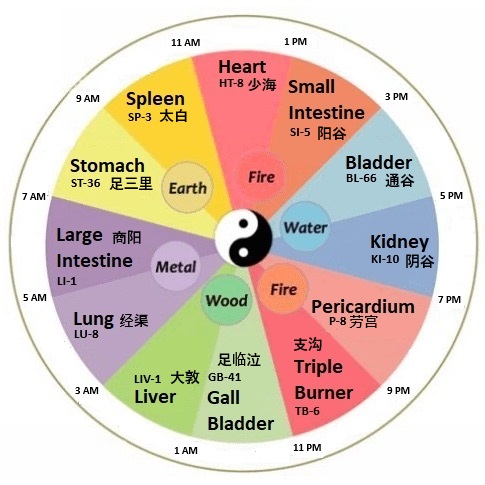
Figure 1: Chinese Organ Clock Visualization
Application of Chronoacupuncture for Jet Lag
Chronoacupuncture hypothesizes that stimulating horary points during their peak activity periods acts as a non-photic synchronizer of circadian rhythms with destination time zones. This approach leverages the Chinese Organ Clock and may modulate peripheral clocks via autonomic or hormonal pathways.
A recent comprehensive review validates that acupuncture significantly affects circadian biology, demonstrating measurable impacts on circadian clock genes, neurotransmitter regulation, and sleep-wake cycles (Wu & Zhao, 2024).11 While these studies employed known acupuncture points known to assist with sleep issues rather than the horary point methodology proposed here, they establish the neurobiological plausibility of acupuncture serving as a non-photic zeitgeber for circadian rhythm modulation.
Methods
The mobile application provides users with timing and instructions to stimulate specific horary points based on the destination time. Ideally starting at the airport (or anytime thereafter), users select the destination. The app immediately identifies the first active horary point matching the destination time. This process is illustrated below.
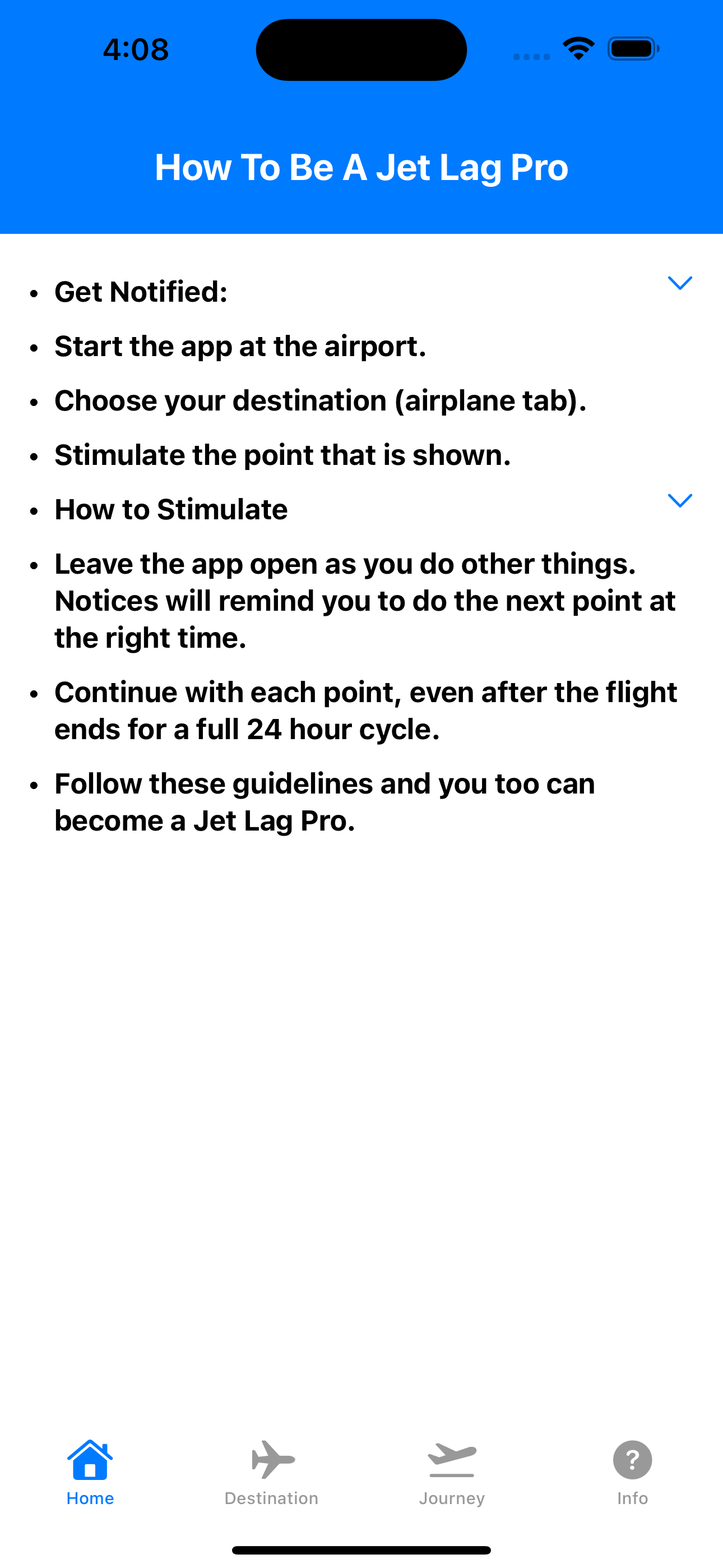
|
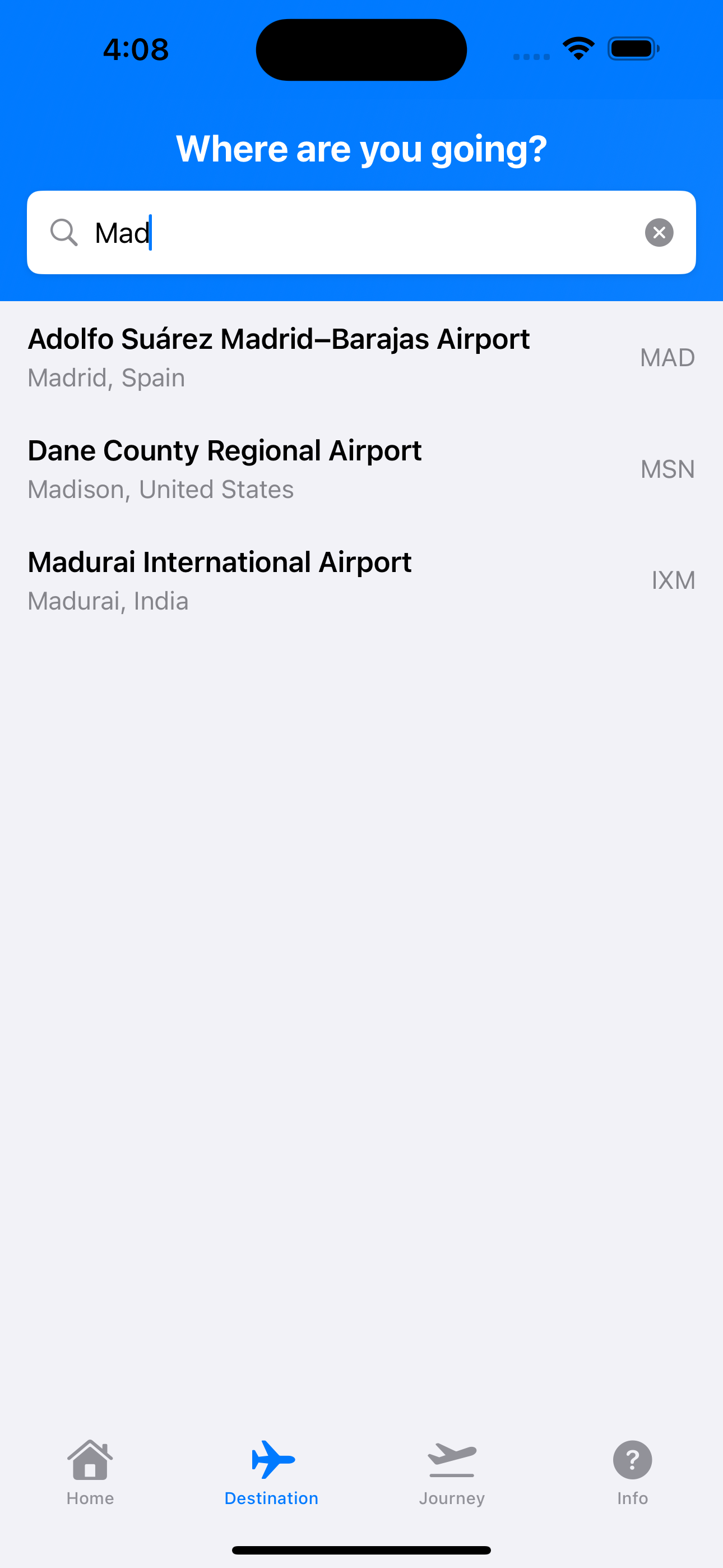
|
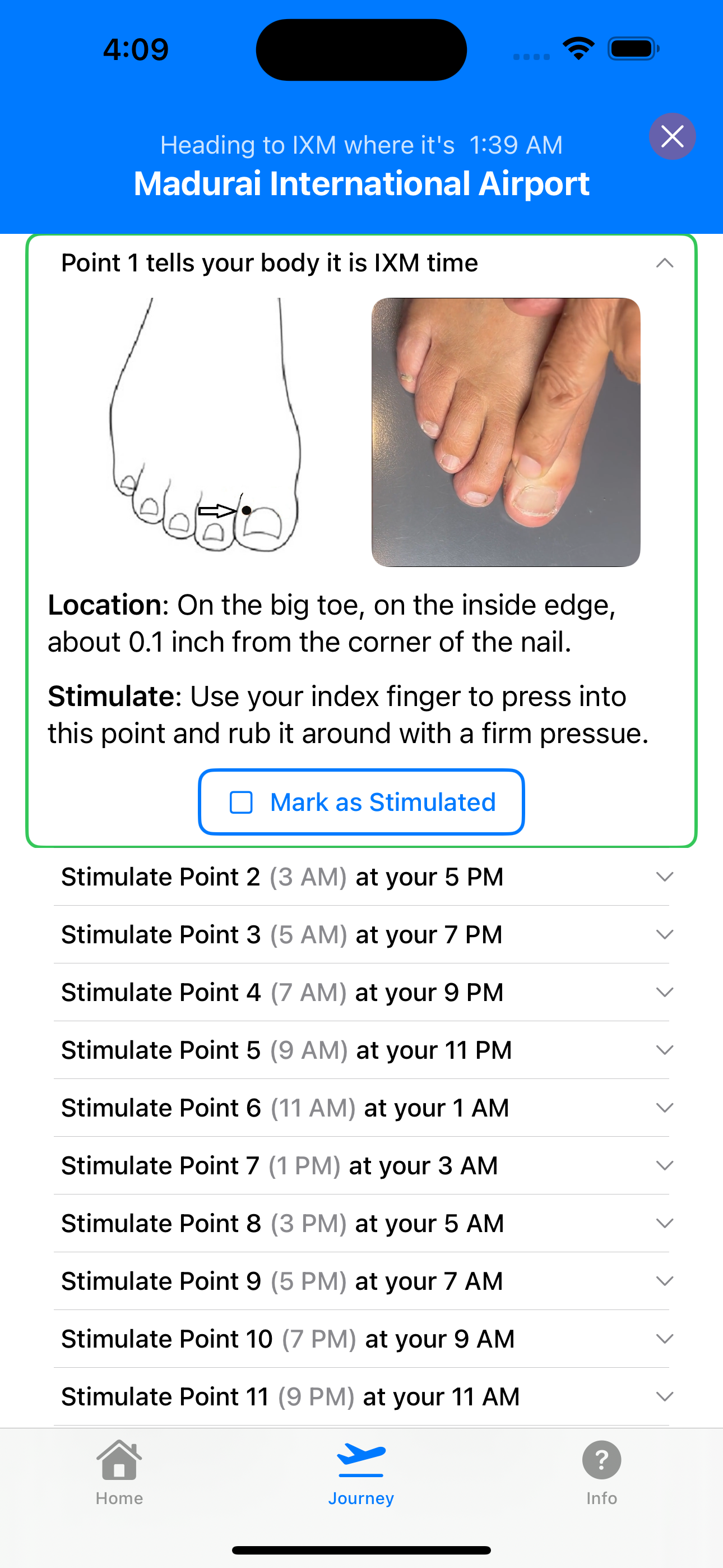
|
|
Screen 1: Basic Instructions |
Screen 2: Destination Selection |
Screen 3: Point Stimulation |
Scheduled reminders pop up at appropriate times prompting the user to complete a full 24-hour cycle. The messages are persistent and remain on the user's phone (or watch) until clicked. When clicked, the user is brought to the Points Screen (#3) of the mobile app which displays the correct horary point image beside a 6-second looping video showing how to stimulate the point. Written instructions are provided below the images.
Horary Point Images
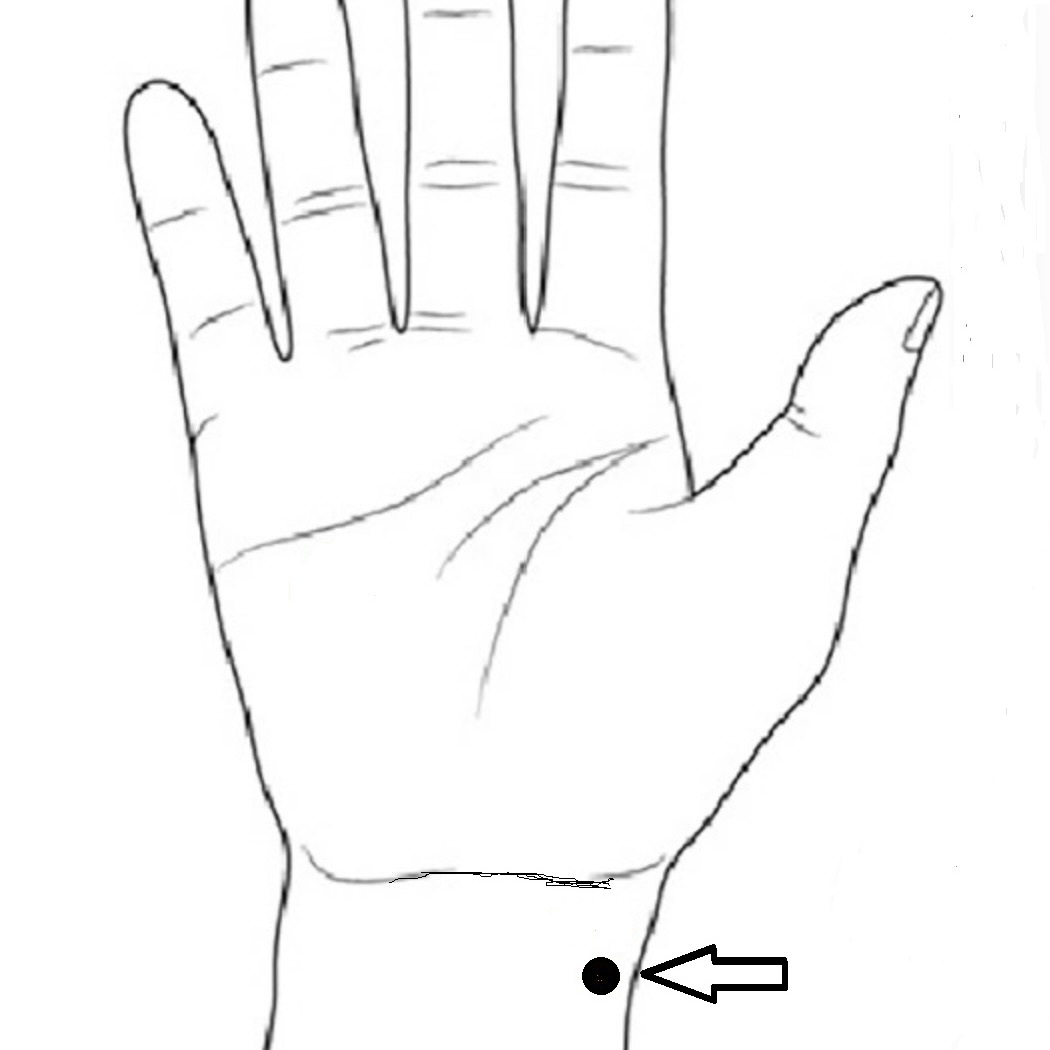
|
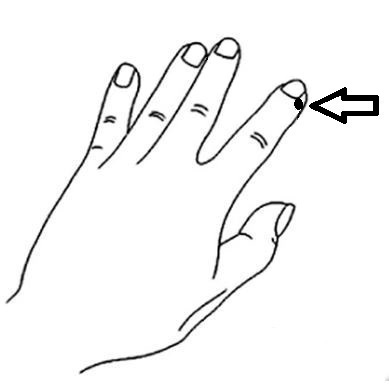
|
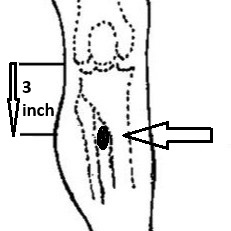
|
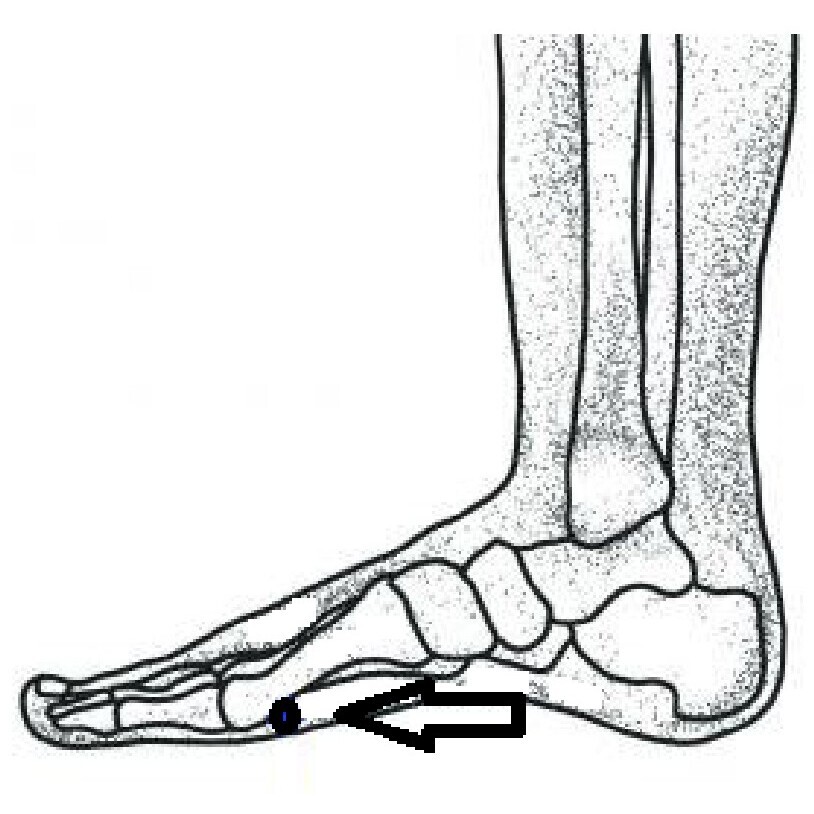
|
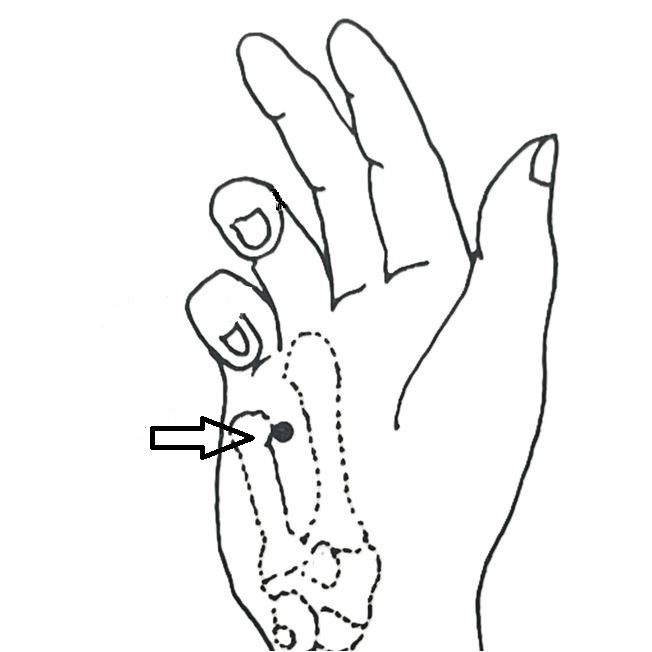
|
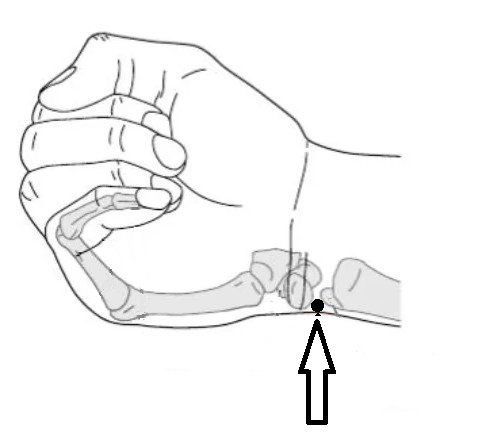
|
|
LU-8 |
LI-1 |
ST-36 |
SP-3 |
HT-8 |
SI-5 |
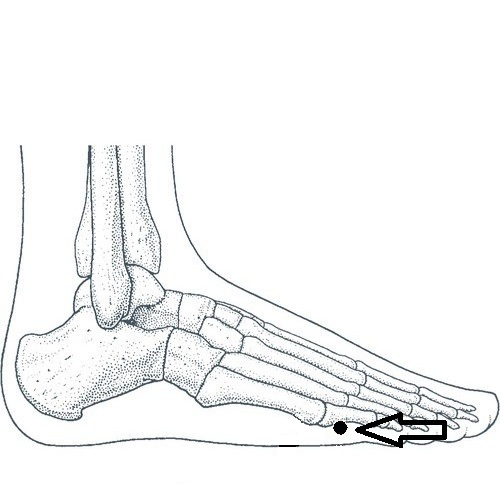
|
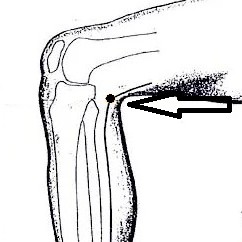
|
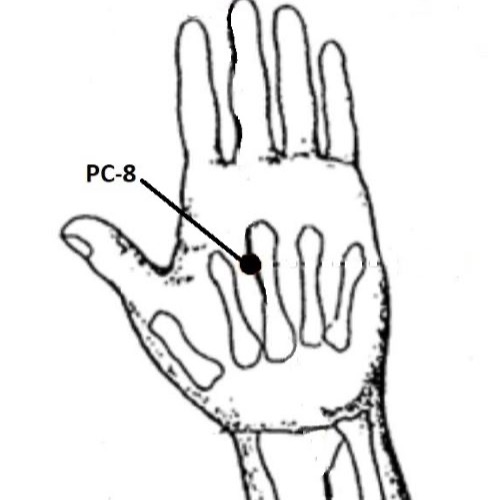
|
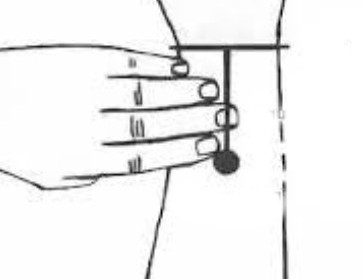
|
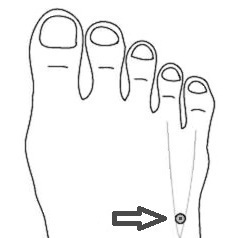
|

|
|
BL-66 |
KI-10 |
PC-8 |
SJ-6 |
GB-41 |
LIV-1 |
After the trip ends, a notification is scheduled for 2 days later to remind the user to complete our website survey. After reviewing existing jet lag questionnaires, we developed a custom survey designed for the specific needs of this study. Participation is voluntary but encouraged by presenting a reward for free lifetime use of the app. This is limited to 1000 respondents. Access to the survey requires a direct link from the app to guarantee authenticity.
Survey Questions look at symptoms and demographics
We ask about anticipated and post-travel symptoms:
|
And, we already have corresponding trip data from the app:
|
Additional questions:
|
Open text field for Comments: |
Data Analysis
The following section is a "work in progress" where categories and analysis may shift and be refined as data is reported. What follows is our current framework.
Primary Research Question
Does chronoacupuncture as provided by the app reduce jet lag symptoms as measured by post-travel symptom severity. We use a within-subject design where each participant serves as their own control. Participants complete surveys that include two separate elements: (1) anticipated symptom severity based on prior travel experience, and (2) post-travel symptom severity as reported sometime after completing their journey.
Baseline Data for Time Zones Crossed
Our analysis compares survey results to baseline severity data from Waterhouse et al.'s 2007 study12. That study shows non-intwerventional severity falls into the following ranges.
- 1-2 time zones: 1.8 severity (1-5 scale)
- 3-5 time zones: 2.5 severity (1-5 scale)
- 6-8 time zones: 3.1 severity (1-5 scale)
- 9+ time zones: 3.6 severity (1-5 scale)
Stimulation Levels
Participants will be grouped by the number of acupressure points reported as stimulated during travel:
- 0-2 points (no intervention)
- 3-5 points (low stimulation)
- 6-8 points (moderate stimulation)
- 9-12 points (high stimulation)
For each stimulation group, we will analyze post-travel symptom severity across different time zone categories to assess how stimulation levels affects the expected symptom increase from crossing more time zones. This grouping balances statistical power with meaningful dose-response differentiation, ensuring adequate sample sizes while maintaining clinically relevant intervention categories.
Dose-Response Analysis Methodology
The primary analysis is a comprehensive dose-response visualization showing the interaction between time zones crossed (X-axis) and aggregate symptom severity (Y-axis) across intervention levels. Each intervention group is represented as a separate line, with the baseline data displayed as a dashed reference line showing expected natural progression without intervention. We present two graphs with the following data.
For each data point, we calculate:
- Mean aggregate symptom severity across all five measured symptoms
- Standard deviation of symptom severity within each group
- Standard error of the mean for statistical precision
- 95% confidence intervals displayed as error bars (±1 SE)
Primary and Secondary Analysis
The main analysis examines the interaction between time zones crossed and points stimulated on post-travel symptom severity. We will:
- Establish the baseline relationship: More time zones = higher post-travel symptoms
- Test the intervention effect: More points stimulated = reduced symptom increase per time zone
- Examine dose-response relationships within each time zone category
- Compare eastward vs. westward travel effects within the stimulation framework
Our secondary analyses examines if anticipated vs. actual symptoms show significant differences.
Live Graphs
Results will be presented in comprehensive tables and figures showing:
- Post-travel symptom severity by time zones crossed and stimulation level
- Dose-response curves showing stimulation effectiveness across time zone categories
- Travel direction effects (eastward vs. westward) within the stimulation framework
What We Can't Control
While acupuncturists are skilled in precise point location and pressure, our typical users are not experts. Some acupressure points such as KI‑10 are harder to locate and stimulate correctly during a flight. In real‑world use, users may:
- mark a point as stimulated without actually stimulating it,
- stimulate a point ineffectively,
- spend too little time on stimulation,
- use insufficient or excessive pressure,
- stimulate only one side, or
- stimulate a point and forget to mark it as done,
- combine other interventions (e.g., meal/sleep scheduling or melatonin).
We expect this variability. Our question is whether chronoacupressure provides benefit for the average user under real‑world conditions. To answer this, we analyze outcomes across a sufficiently large sample so that any true signal rises above noise.
Additional Research Questions to be Answered
This analysis framework will directly address our primary research questions:
- Are there differential effects based on travel direction (eastward vs. westward) within the stimulation framework?
Comprehensive Data Visualization
Results are presented through an integrated analytics dashboard featuring:
- Primary Dose-Response Chart: Multi-line visualization showing intervention effectiveness vs. baseline across all time zones with statistical error bars
- Individual Symptom Analysis: Detailed breakdown of effectiveness for sleep, fatigue, concentration, irritability, and gastrointestinal symptoms
- Statistical Summary Tables: Comprehensive data tables showing mean severity, standard error, and sample sizes for each intervention-timezone combination
- Recent Submissions Tracking: Real-time monitoring of survey completion rates and data quality
Results
Pending....Discussion
The proposed mechanism for chronoacupuncture involves stimulation of acupressure points triggering afferent nerve pathways that may influence the hypothalamic-pituitary-adrenal axis and autonomic nervous system. This peripheral stimulation could modulate melatonin secretion patterns, cortisol rhythms, and peripheral clock gene expression, effectively serving as a non-photic zeitgeber to accelerate circadian realignment.
This paper presents an exploratory study aiming to gather preliminary statistical evidence across diverse travel conditions, addressing the absence of formal chronoacupuncture jet lag studies. While anecdotal reports from acupuncturists suggest efficacy, this platform seeks to validate or refute chronoacupuncture as a non-pharmacological tool for jet lag management. At present, the app is in beta testing among a small number of users that the author has identified as qualified. Within the next year, we hope to be able to present results.
Traditional clinical trials face significant challenges in jet lag research due to the logistical complexity of controlling travel variables, participant demographics, and environmental factors. Our app's naturalistic data collection approach using a well defined survey approach circumvents these limitations while capturing real-world efficacy across diverse travel conditions. However, this methodology introduces potential confounding variables including participant compliance, placebo effects inherent in tactile interventions, and subjective symptom reporting.
The interdisciplinary framework merging ancient temporal concepts with circadian biology creates a testable hypothesis from traditionally anecdotal practices. If validated, chronoacupuncture could provide a non-invasive, cost-effective intervention accessible to travelers without medical supervision. Negative findings would redirect research toward alternative non-photic zeitgebers and inform the scientific evaluation of other TCM temporal therapies.
Summary
Chronoacupuncture represents a testable hypothesis merging Traditional Chinese Medicine's horary point theory with contemporary circadian biology. The JetLagPro platform enables systematic evaluation of whether sequential acupressure stimulation can function as a non-photic zeitgeber, potentially modulating circadian rhythms through peripheral nerve pathways and hormonal signaling.
Success metrics include reduced jet lag symptom severity, accelerated adaptation times, and correlation between compliance and outcomes across diverse travel conditions. Validation would establish an accessible, non-pharmacological intervention for the 90% of long-haul travelers experiencing jet lag. Negative results would inform the scientific assessment of TCM temporal therapies and guide development of alternative circadian interventions.
This interdisciplinary approach demonstrates how mobile technology can bridge traditional medicine and modern research methodologies, creating scalable platforms for evidence-based evaluation of culturally-rooted health practices in contemporary medical contexts.
References
- Waterhouse, J., Reilly, T., Atkinson, G., & Edwards, B. (2007). Liverpool Jet Lag Questionnaire: validation and baseline data from athletes and travelers. Chronobiology International, 24(6), 1065-1084. https://doi.org/10.1080/07420520701791505
Provides baseline severity data from Liverpool Jet Lag Questionnaire administered to athletes and travelers, establishing control reference points for natural jet lag severity without intervention across different time zone transitions (1.8 severity for 1-2 zones, 2.5 for 3-5 zones, 3.1 for 6-8 zones, 3.6 for 9+ zones on 1-5 scale). - Panda, S. (2022). Foundations of circadian medicine. PLoS Biology, 20(3), e3001567. https://doi.org/10.1371/journal.pbio.3001567
Comprehensive essay outlining how circadian medicine can exploit mechanisms of circadian physiology and clock-disease interactions for clinical diagnosis, treatment, and prevention, establishing a framework for timing-based medical interventions. - Honma, S., & Honma, K.I. (2019). The mammalian circadian timing system and the suprachiasmatic nucleus as its pacemaker. Biology, 8(1), 13. https://doi.org/10.3390/biology8010013
Comprehensive review of the suprachiasmatic nucleus as the central circadian pacemaker, covering molecular clockwork, neuronal networks, and intercellular communication mechanisms that generate and maintain mammalian circadian rhythms. - Paschos, G.K., & FitzGerald, G.A. (2010). Circadian clocks and vascular function. Circulation Research, 106(5), 833-841. https://doi.org/10.1161/CIRCRESAHA.109.211706
Comprehensive review demonstrating that circadian clocks regulate vascular function through control of blood pressure rhythms, thrombogenesis, endothelial function, and response to vascular injury, based on genetic disruption studies in clock-deficient mice. - Hastings, M. H., et al. (2003). A clockwork web: circadian timing in brain and periphery. Nature Reviews Neuroscience, 4(8), 649–661. https://doi.org/10.1038/nrn1177
Comprehensive review establishing the hierarchical organization of mammalian circadian timing, from the suprachiasmatic nucleus master clock to peripheral tissue oscillators, and demonstrating how clock disruption contributes to disease pathogenesis across multiple physiological systems. - Nangle, S. N., Rosensweig, C., Koike, N., Tei, H., Takahashi, J. S., Green, C. B., & Zheng, N. (2014). Molecular assembly of the period-cryptochrome circadian transcriptional repressor complex. eLife, 3, e03674. https://doi.org/10.7554/eLife.03674
Crystal structure analysis of the Period-Cryptochrome complex revealing the molecular basis of circadian transcriptional repression, demonstrating how Period and Cryptochrome proteins interact to form the core negative feedback loop that drives mammalian circadian rhythms. - Heyde, I., & Oster, H. (2019). Differentiating external zeitgeber impact on peripheral circadian clock resetting. Scientific Reports, 9, 20114. https://doi.org/10.1038/s41598-019-56323-z
Experimental study demonstrating differential effects of light versus food timing on peripheral tissue clocks, showing that zeitgeber desynchrony leads to tissue-specific phase responses and metabolic consequences including cyclic weight changes. - Huangdi Neijing (Yellow Emperor's Inner Canon). [Classical text, no online link available]
Foundational ancient Chinese medical text establishing the theoretical basis for the Chinese Organ Clock, horary point theory, and the circulation of qi through twelve meridians over 24-hour cycles in Traditional Chinese Medicine. - Khoe, W.H. (1978). Treatment of jet lag syndrome by acupuncture. American Journal of Acupuncture, 6(2), 135–139.
Historical paper on acupuncture treatment for jet lag syndrome (content not accessible for detailed summary). - Amaro, J. (2001). Time Travel: Contemporary Applications for Jet Lag from Ancient Principles. Acupuncture Today, October 2001. https://acupuncturetoday.com/article/27861-time-travel-contemporary-applications-for-jet-lag-from-ancient-principles
Practical guide detailing the systematic application of horary points from Traditional Chinese Medicine for jet lag treatment, providing specific protocols for stimulating meridian points based on destination time zones during flight. - Wu, J., & Zhao, Z. (2024). Acupuncture in circadian rhythm sleep–wake disorders and its potential neurochemical mechanisms. Frontiers in Neuroscience, 18, 1346635. https://doi.org/10.3389/fnins.2024.1346635
Comprehensive review demonstrating that acupuncture significantly affects circadian biology through modulation of circadian clock genes (Per1, Per2, Clock, Bmal1), neurotransmitter regulation (5-HT, dopamine, GABA), and melatonin pathways, establishing acupuncture as a non-photic zeitgeber for circadian rhythm disorders. - Waterhouse, J., et al. (2007). Jet lag: trends and coping strategies. The Lancet, 369(9567), 1117–1129. https://doi.org/10.1016/S0140-6736(07)60529-7
Reviews jet lag symptoms, causes, and methods to alleviate negative effects of time-zone transitions, including advice for travelers flying in different directions across multiple time zones.